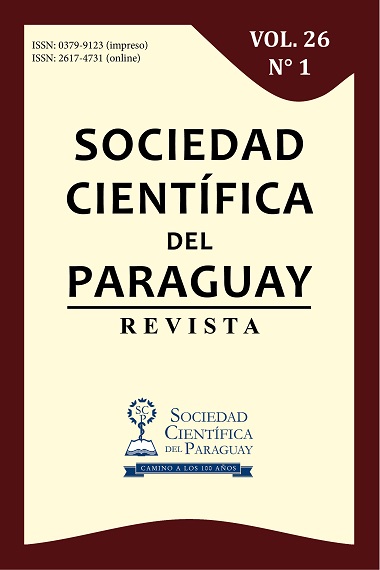Dynamics of forest fires in the San Rafael National Park Reserve, Paraguay, period 2007-2017
DOI:
https://doi.org/10.32480/rscp.2021.26.1.17Keywords:
forest fires, MODIS sensor, rainfall regime, heat sourcesAbstract
Every year the San Rafael National Park Reserve (RPNSR) is affected by forest fires that cause damage to extensive areas of both forests and natural grasslands and other components of biodiversity. This can result in an inconvenience if the corresponding measures are not taken in the management of these phenomena. Therefore, the main objective was to analyze the dynamics of forest fires in the RPNSR, through a multi-temporal analysis in the period 2007-2017, with the detailed recording of heat sources captured by the MODIS sensor and analysis with geographic information systems. Comparison and analysis with monthly rainfall data. The same ones gave as result that indistinctly of the pluviometric regime given throughout the period of analysis, fires were registered. In relation to the amount of heat sources registered monthly, the months of greater registry of heat sources go from June to November, being the months of July and August those that more repeatedly present the highest peaks. Based on these results and analyzing the history of actions in forest fire management already undertaken by organizations and institutions in the RPNSR, a Forest Fire Prevention and Control Plan was proposed with the most important points.
Metrics
Downloads
References
2. De Egea Juvinel J, Balbuena C. Altos valores de conservación de recursos naturales en la Reserva San Rafael. WWF, Guyra Paraguay, Asunción. 2011. Disponible en http://cbuilding.org/sites/default/files/HCV_San_Rafael_Paraguay_PT1.pdf
3. Amarilla Rodríguez S, Yanosky A, Villalba J. San Rafael Reserve, Paraguay: social stakeholders and sustainability scenarios through environmental governance approaches. In: Delgado L.E. and Marín V.H. (eds.) Social-ecological systems of Latin America: complexities and challenges. Springer Nature Switzerland AG; 2019,pp. 229-246. 2019.
4. Amarilla Rodríguez, S. Acceso y uso del recurso forestal y escenarios de sostenibilidad de la Reserva de Recursos Manejados San Rafael, Paraguay. Tesis M. Sc. Turrialba, Costa Rica, CATIE; 2004, 241p.
5. Esquivel Mattos A, Peris SJ. Aves de San Rafael. Asunción; 2011.
6. Guyra Paraguay. Áreas Importantes para la Conservación de las Aves del Paraguay. Asunción; 2008.
7. Morfin-Ríos JE, Jardel PE, Alvarado C, Michel-Fuentes JM. Caracterización y cuantificación de combustibles forestales. Comisión Nacional Forestal-Universidad de Guadalajara. Guadalajara, Jalisco, México; 2012.
8. Castillo M, Pedernera P, Peña E. Incendios forestales y medio ambiente: una síntesis global. Revista Ambiente y Desarrollo de CIPMA. 2003;19 (3):44-53.
9. PROCOSARA (Asociación Pro Cordillera San Rafael). Reseña histórica de labores de Prevención y Control de Incendios Forestales en la Reserva de San Rafael y sus zonas de amortiguamiento (documentos internos). Pro Cordillera San Rafael, Hohenau; 2018.
10. Delphin Pérez S, Pinazzo J, Fatecha H, Amarilla S. Caracterización de incendios a través de imágenes satelitales de mediana y alta resolución en la reserva de recursos manejados San Rafael y su zona de amortiguamiento, Región Oriental. Investigación Agraria. 2005;7(2):65-70.
11. Cartes J, Yanosky A. La Cordillera San Rafael: un capítulo particular en la conservación del BAAPA en Paraguay. In: Cartes JL (ed) El Bosque Atlántico en Paraguay: biodiversidad, amenazas y perspectivas. Asociación Guyra Paraguay. Asunción; 2005, p 177-201.
12. Insfrán Chena P, González R, Gill A, Villalba J, Amarilla S. Caracterización de la degradación de la vegetación en la Reserva para Parque San Rafael, Paraguay y pautas generales para su restauración. Paraquaria Natural. 2019;7(1):34-42.
13. Universidad Nacional de Asunción, Facultad de Ciencias Agrarias. Proyecto Sistematización de la Información sobre San Rafael. Informe Final para el Fondo de Conservación de Bosques Tropicales. Disponible en: http://fondodeconservaciondebosques.org.py. 2012.
14. Instituto Nacional de Pesquisas Espaciais, INPE. Plataforma Virtual. 2018. Disponible em: http://www.inpe.br/
15. Souza Jr C, Azevedo T. MapBiomas General "Handbook" Algorithm Theoretical Basis Document (ATBD). 2017. Disponible en: https://mapbiomas-br-site.s3.amazonaws.com/ATBD_Collection_5_v1.pdf
16. Ramos Rodríguez M, Viana Soares R. Análisis comparativo entre los incendios forestales en Monte Alegre, Brasil y Pinar del Río, Cuba. Floresta. 2004;34(2):101-10.
Downloads
Published
Issue
Section
License
El/los autores autorizan a la Revista de la Sociedad Científica del Paraguay a publicar y difundir el articulo del cual son autores, por los medios que considere apropiado.


















